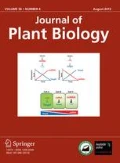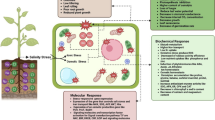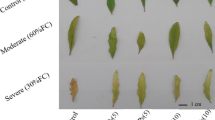Abstract
Autotoxicity in plants limits their growth and that of nearby plants of the same species, which has obvious implications in crop yield and quality. Silicon (Si) has been shown to increase plant tolerance to autotoxic stress. However, the physiological mechanisms underlying the effects of Si in alleviating autotoxicity during germination in cucumber (Cucumis sativus L.) are unknown. Cinnamic acid derivatives, such as 3-phenylpropionic acid (PA), are a class of autotoxins present in cucumber root exudates. Our objective was to investigate Si-induced autotoxic stress tolerance in cucumber seedlings by focusing on the effects of Si on the induction of antioxidant defense pathways. We found that PA treatment significantly reduced seed germination, radicle length, lateral root number, fresh weight, AsA and GSH contents, and the activities of SOD, CAT, and APX in cucumber seedlings, while it increased membrane permeability and levels of MDA, proline, O -2 , and H2O2. Application of Si enhanced growth of PA-treated plants and significantly increased germination rate, radicle length, lateral root number, fresh weight, AsA and GSH levels, and SOD, CAT, POD, and APX activities. These results suggest that exogenous Si alleviates autotoxicity caused by PA during seed germination by increasing antioxidant enzyme activities and mitigating lipid peroxidation.
Similar content being viewed by others
References
Agarie S, Hanaoka N, Ueno O, Miyazaki A, Kubota F (1998) Effects of silicon on tolerance to water deficit and heat stress in rice plants (Oryza sativa L.), monitored by electrolyte leakage. Plant Prod Sci 1:96–103
Al-aghabary K, Zhu Z, Shi Q (2005) Influence of silicon supply on chlorophyll content, chlorophyll fluorescence, and antioxidative enzyme activities in tomato plants under salt stress. J Plant Nutr 27:2101–2115
Asada K (1992) Ascorbate peroxidase-a hydrogen peroxide-scavenging enzyme in plants. Physiol Plantarum 85:235–241
Ashraf M, Afzal M, Ahmed R, Mujeeb F, Sarwar A, Ali L (2010) Alleviation of detrimental effects of NaCl by silicon nutrition in salt-sensitive and salt-tolerant genotypes of sugarcane (Saccharum officinarum L.). Plant Soil 326:381–391
Bates LS, Waldren RP, Teare ID (1973) Rapid determination of free proline for water-stress studies. Plant Soil 39:205–207
Batish DR, Singh HP, Kaur S, Kohli RK, Yadav SS (2008) Caffeic acid affects early growth, and morphogenetic response of hypocotyl cuttings of mung bean (Phaseolus aureus). J Plant Physiol 165:297–305
Chen W, Yao XQ, Cai KZ, Chen JN (2011) Silicon alleviates drought stress of rice plants by improving plant water status, photosynthesis and mineral nutrient absorption. Biol Trace Elem Res 142:67–76
Chérif M, Asselin A, Bélanger RR (1994) Defense responses induced by soluble silicon in cucumber roots infected by Pythium spp. Phytopathology 84:236–242
Dai AH, Nie YX, Yu B, Li Q, Lu LY, Bai JG (2012) Cinnamic acid pretreatment enhances heat tolerance of cucumber leaves through modulating antioxidant enzyme activity. Environ Exp Bot 79:1–10
Dhindsa RS, Plumb-Dhindsa P, Thorpe TA (1981) Leaf senescence: correlated with increased levels of membrane permeability and lipid peroxidation, and decreased levels of superoxide dismutase and catalase. J Exp Bot 32:93–101
Díaz-Vivancos P, Rubio M, Mesonero V, Periago PM, Barceló AR, Martínez-Gómez P, Hernández JA (2006) The apoplastic antioxidant system in Prunus: response to long-term plum pox virus infection. J Exp Bot 57:3813–3824
Ding J, Sun Y, Xiao CL, Shi K, Zhou YH, Yu JQ (2007) Physiological basis of different allelopathic reactions of cucumber and figleaf gourd plants to cinnamic acid. J Exp Bot 58:3765–3773
Elstner EF, Heupel A (1976) Inhibition of nitrite formation from hydroxylammoniumchloride: a simple assay for superoxide dismutase. Anal Biochem 70:616–620
Epstein E (1994) The anomaly of silicon in plant biology. Proc Natl Acad Sci USA 91:11–17
Epstein E (1999) Silicon. Ann Rev Plant Biol 50:641–664
Fath A, Bethke PC, Jones RL (2001) Enzymes that scavenge reactive oxygen species are down-regulated prior to gibberellic acidinduced programmed cell death in barley aleurone. Plant Physiol 126:156–166
Foyer CH, Descourvieres P, Kunert KJ (1994) Protection against oxygen radicals: an important defence mechanism studied in transgenic plants. Plant Cell Environ 17:507–523
Foyer CH, Lelandais M, Kunert KJ (1994) Photooxidative stress in plants. Physiol Plantarum 92:696–717
Foyer CH, Theodoulou FL, Delrot S (2001) The functions of interand intracellular glutathione transport systems in plants. Trends Plant Sci 6:486–492
Fridovich I (1975) Superoxide dismutases. Annu Rev Biochem 44:147–159
Gezi L, Xiaoqi P, Liting W, Guozhang K (2013) Salicylic acid increases the contents of glutathione and ascorbate and temporally regulates the related gene expression in salt-stressed wheat seedlings. Gene 529:321–325
Gong HJ, Chen KM, Zhao ZG, Chen GC, Zhou WJ (2008) Effects of silicon on defense of wheat against oxidative stress under drought at different developmental stages. Biol Plantarum 52:592–596
Gong HJ, Zhu XY, Chen KM, Wang SM, Zhang CL (2005) Silicon alleviates oxidative damage of wheat plants in pots under drought. Plant Sci 169:313–321
Gunes A, Inal A, Bagci E G, Coban S, Pilbeam DJ (2007a) Silicon mediates changes to some physiological and enzymatic parameters symptomatic for oxidative stress in spinach (Spinacia oleracea L.) grown under B toxicity. Sci Hortic 113:113–119
Gunes A, Inal A, Bagci EG, Coban S, Sahin O (2007b) Silicon increases boron tolerance and reduces oxidative damage of wheat grown in soil with excess boron. Biol Plantarum 51:571–574
Guri A (1983) Variation in glutathione and ascorbic acid content among selected cultivars of Phaseolus vulgaris prior to and after exposure to ozone. Can J Plant Sci 63:733–737
Hwang SY, Lin HW, Chern RH, Lo HF, Li L (1999) Reduced susceptibility to waterlogging together with high-light stress is related to increases in superoxide dismutase and catalase activities in sweet potato. Plant Growth Regul 27:167–172
Hodson MJ, White PJ, Mead A, Broadley MR (2005) Phylogenetic variation in the silicon composition of plants. Ann Bot (Lond.) 96:1027–1046
Jarvis SC (1987) The uptake and transport of silicon by perennial ryegrass and wheat. Plant Soil 97:429–437
Jiménez A, Hernández JA, Pastori G, Río LAD, Sevilla F (1998) Role of the ascorbate-glutathione cycle of mitochondria and peroxisomes in the senescence of pea leaves. Plant Physiol 118:1327–1335
Jones LHP, Handreck KA (1967) Silica in soils, plants and animals. Adv Agron 19:107–149
Kampfenkel K, Vanmontagu M, Inze D (1995) Extraction and determination of ascorbate and dehydroascorbate from plant tissue. Anal Biochem 225:165–167
Kauss H, Seehaus K, Franke R, Gilbert S, Dietrich RA, Kröger N (2003) Silica deposition by a strongly cationic proline-rich protein from systemically resistant cucumber plants. Plant J 33:87–95
Kim SG, Kim KW, Park EW, Choi D. (2002) Silicon-induced cell wall fortification of rice leaves: a possible cellular mechanism of enhanced host resistance to blast. Phytopathology 92(10):1095–1103
Kumar GNM, Knowles NR (1993) Changes in lipid peroxidation and lipolytic and free-radical scavenging enzyme activities during aging and sprouting of potato (Solanum tuberosum) seed-tubers. Plant Physiol 102:115–124
Laloi C, Apel K, Danon A (2004) Reactive oxygen signalling: the latest news. Curr Opin Plant Biol 7:323–328
Liang Y (1999) Effects of silicon on enzyme activity and sodium, potassium and calcium concentration in barley under salt stress. Plant Soil 209:217–224
Liang Y, Si J, Römheld V (2005a) Silicon uptake and transport is an active process in Cucumis sativus. New Phytol 167(3):797–804
Liang Y, Sun W, Zhu YG, Christie P (2007) Mechanisms of siliconmediated alleviation of abiotic stresses in higher plants: a review. Environ Pollut 147:422–428
Liang Y, Wong JWC, Wei L (2005c) Silicon-mediated enhancement of cadmium tolerance in maize (Zea mays L.) grown in cadmium contaminated soil. Chemosphere 58:475–483
Liang YC, Shen QR, Shen ZG, Ma TS (1996) Effects of silicon on salinity tolerance of two barley cultivars. J Plant Nutr 19:173–183
Liang YC, Zhang WH, Chen Q, Ding RX (2005b) Effects of silicon on tonoplast H+-ATPase and H+-PPase activity, fatty acid composition and fluidity in roots of salt-stressed barley (Hordeum vulgare L.). Environ Exp Bot 53:29–37
Liang YC, Zhang WH, Chen Q, Liu YL, Ding RX (2006) Effect of exogenous silicon (Si) on H+-ATPase activity, phospholipids and fluidity of plasma membrane in leaves of salt-stressed barley (Hordeum vulgare L.). Environ Exp Bot 57:212–219
Liang YC, Zhu J, Li ZJ, Chu GX, Ding YF, Zhang J, Sun WC (2008) Role of silicon in enhancing resistance to freezing stress in two contrasting winter wheat cultivars. Environ Exp Bot 64:286–294
Livak KJ, Schmittgen TD (2001) Analysis of relative gene expression data using real-time quantitative PCR and the 2-??CT method. Methods 25:402–408
Luster DG, Donaldson RP (1987) Orientation of electron transport activities in the membrane of intact glyoxysomes isolated from castor bean endosperm. Plant Physiol 85:796–800
Lutts S, Kinet JM, Bouharmont J (1996) NaCl-induced senescence in leaves of rice (Oryza sativa L.) cultivars differing in salinity resistance. Ann Bot-London 78:389–398
Ma DY, Sun DX, Wang CY, Qin HX, Ding HN, Li YG, Guo TC (2015) Silicon application alleviates drought stress in wheat through transcriptional regulation of multiple antioxidant defense pathways. J Plant Growth Regul pp. 1–10
Ma JF (2004) Role of silicon in enhancing the resistance of plants to biotic and abiotic stresses. Soil Sci Plant Nutr 50:11–18
Ma JF, Takahashi E (2002) Soil, fertilizer, and plant silicon research in Japan. Elsevier
Ma JF, Tamai K, Yamaji N, Mitani N, Konishi S, Katsuhara M (2006) A silicon transporter in rice. Nature 440:688–691
Ma JF, Yamaji N (2006) Silicon uptake and accumulation in higher plants. Trends Plant Sci 11:392–397
Maksimoviæ JD, Mojoviæ M, Maksimoviæ V, Römheld V, Nikolic M (2012) Silicon ameliorates manganese toxicity in cucumber by decreasing hydroxyl radical accumulation in the leaf apoplast. J Exp Bot 63:2411–2420
Mateos-Naranjo E, Andrades-Moreno L, Davy AJ (2013) Silicon alleviates deleterious effects of high salinity on the halophytic grass Spartina densiflora. Plant Physiol Bioch 63:115–121
Mukherjee SP, Choudhuri MA (1983) Implications of water stressinduced changes in the levels of endogenous ascorbic acid and hydrogen peroxide in Vigna seedlings. Physiol Plantarum 58:166–170
Nakano Y, Asada K (1981) Hydrogen peroxide is scavenged by ascorbate-specific peroxidase in spinach chloroplasts. Plant Cell Physiol 22:867–880
Noctor G, Foyer CH (1998) Ascorbate and glutathione: keeping active oxygen under control. Annu Rev Plant Biol 49:249–279
Pereira GJG, Molina SMG, Lea PJ, Azevedo RA (2002) Activity of antioxidant enzymes in response to cadmium in Crotalaria juncea. Plant Soil 239:123–132
Ramiro DA, Guerreiro-Filho O, Mazzafera P (2006) Phenol contents, oxidase activities, and the resistance of coffee to the leaf miner Leucoptera coffeella. J Chem Ecol 32:1977–1988
Richmond KE, Sussman M (2003) Got silicon? The non-essential beneficial plant nutrient. Curr. Opin. Plant Biol 6:268–272
Rodriguez R, Redman R (2005) Balancing the generation and elimination of reactive oxygen species. Proc Natl Acad Sci USA 102:3175–3176
Shan C, He F, Xu G, Han R, Liang Z (2012) Nitric oxide is involved in the regulation of ascorbate and glutathione metabolism in Agropyron cristatum leaves under water stress. Biol Plantarum 56:187–191
Shen XF, Zhou YY, Duan LS, Li ZH, Eneji AE, Li JM (2010) Silicon effects on photosynthesis and antioxidant parameters of soybean seedlings under drought and ultraviolet-B radiation. J Plant Physiol 167:1248–1252
Shi QH, Bao ZY, Zhu ZJ, He Y, Qian QQ, Yu JQ (2005) Siliconmediated alleviation of Mn toxicity in Cucumis sativus in relation to activities of superoxide dismutase and ascorbate peroxidase. Phytochemistry 66:1551–1559
Song AL, Li ZJ, Zhang J, Xue GF, Fan FL, Liang YC (2009) Siliconenhanced resistance to cadmium toxicity in Brassica chinensis L. is attributed to Si-suppressed cadmium uptake and transport and Si-enhanced antioxidant defense capacity. J Hazard Mater 172:74–83
Van der Vorm PDJ (1987) Dry ashing of plant material and dissolution of the ash in HF for the colorimetric determination of silicon. Commun Soil Sci Plan 18:1181–1189
Vyas D, Kumar S (2005) Purification and partial characterization of a low temperature responsive Mn-SOD from tea (Camellia sinensis (L.) O. Kuntze). Biochem Bioph Res Co 329(3):831–838
Xie ZX, Duan LS, Tian XL, Wang BM, Eneji AE, Li ZH (2008) Coronatine alleviates salinity stress in cotton by improving the antioxidative defense system and radical-scavenging activity. J Plant Physiol 165:375–384
Ye SF, Zhou YH, Sun Y, Zou LY, Yu JQ (2006) Cinnamic acid causes oxidative stress in cucumber roots, and promotes incidence of Fusarium wilt. Environ Exp Bot 56:255–262
Yu JQ, Matsui Y (1997) Effects of root exudates of cucumber (Cucumis sativus) and allelochemicals on ion uptake by cucumber seedlings. J Chem Ecol 23:817–827
Yu JQ, Matsui Y (1994) Phytotoxic substances in root exudates of cucumber (Cucumis sativus L.). J Chem Ecol 20:21–31
Yu JQ, Shou SY, Qian YR, Zhu ZJ, Hu WH (2000) Autotoxic potential of cucurbit crops. Plant Soil 223:149–153
Yu JQ, Ye SF, Zhang MF, Hu WH (2003) Effects of root exudates and aqueous root extracts of cucumber (Cucumis sativus) and allelochemicals, on photosynthesis and antioxidant enzymes in cucumber. Biochem Syst Ecol 31:129–139
Zhang PY, Gao RG, Yang FJ, Wang XF, Wei M, Shi QH, Li Y (2014) Effects of silicon on photosynthetic characteristics and activity of antioxidant enzymes in continuous-cropped cucumber seedlings. Chinese Journal of Applied Ecology 25:1733–1738
Zhang Y, Gu M, Xia XJ, Shi K, Zhou YH, Yu JQ (2009) Effects of phenylcarboxylic acids on mitosis, endoreduplication and expression of cell cycle-related genes in roots of cucumber (Cucumis sativus L.). J Chem Ecol 35:679–688
Zhu ZJ, Wei GQ, Li J, Qian QQ, Yu JQ (2004) Silicon alleviates salt stress and increases antioxidant enzymes activity in leaves of salt-stressed cucumber (Cucumis sativus L.). Plant Sci 167:527–533
Author information
Authors and Affiliations
Corresponding author
Rights and permissions
About this article
Cite this article
Bu, R., Xie, J., Yu, J. et al. Autotoxicity in cucumber (Cucumis sativus L.) seedlings is alleviated by silicon through an increase in the activity of antioxidant enzymes and by mitigating lipid peroxidation. J. Plant Biol. 59, 247–259 (2016). https://doi.org/10.1007/s12374-016-0526-1
Received:
Accepted:
Published:
Issue Date:
DOI: https://doi.org/10.1007/s12374-016-0526-1




